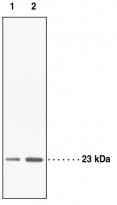ARG56466
anti-Prostaglandin E Synthase (cytosolic, FL) antibody
anti-Prostaglandin E Synthase (cytosolic, FL) antibody for ICC/IF,Western blot and Human,Mouse
Overview
| Product Description | Rabbit Polyclonal antibody recognizes Prostaglandin E Synthase (cytosolic, FL) |
|---|---|
| Tested Reactivity | Hu, Ms |
| Tested Application | ICC/IF, WB |
| Specificity | This antibody does not react to Microsomal PGES-1 and Microsomal PGES-2. |
| Host | Rabbit |
| Clonality | Polyclonal |
| Isotype | IgG |
| Target Name | Prostaglandin E Synthase (cytosolic, FL) |
| Antigen Species | Human |
| Immunogen | Full length, Human recombinant Prostaglandin E Synthase (cytosolic, FL). |
| Conjugation | Un-conjugated |
| Alternate Names | EC 5.3.99.3; Progesterone receptor complex p23; TEBP; Hsp90 co-chaperone; P23; cPGES; Cytosolic prostaglandin E2 synthase; Prostaglandin E synthase 3; Telomerase-binding protein p23 |
Application Instructions
| Application Suggestion |
|
||||||
|---|---|---|---|---|---|---|---|
| Application Note | * The dilutions indicate recommended starting dilutions and the optimal dilutions or concentrations should be determined by the scientist. |
Properties
| Form | Liquid |
|---|---|
| Purification | Affinity purification with immunogen. |
| Storage Instruction | For continuous use, store undiluted antibody at 2-8°C for up to a week. For long-term storage, aliquot and store at -20°C. Storage in frost free freezers is not recommended. Avoid repeated freeze/thaw cycles. Suggest spin the vial prior to opening. The antibody solution should be gently mixed before use. |
| Note | For laboratory research only, not for drug, diagnostic or other use. |
Bioinformation
| Database Links | |
|---|---|
| Gene Symbol | PTGES3 |
| Gene Full Name | prostaglandin E synthase 3 (cytosolic) |
| Function | Cytosolic prostaglandin synthase that catalyzes the oxidoreduction of prostaglandin endoperoxide H2 (PGH2) to prostaglandin E2 (PGE2). Molecular chaperone that localizes to genomic response elements in a hormone-dependent manner and disrupts receptor-mediated transcriptional activation, by promoting disassembly of transcriptional regulatory complexes. Facilitates HIF alpha proteins hydroxylation via interaction with EGLN1/PHD2, leading to recruit EGLN1/PHD2 to the HSP90 pathway. [UniProt] |
| Calculated MW | 19 kDa |
Images (1) Click the Picture to Zoom In






